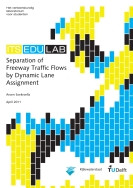The thesis deals with the separation of freeway traffic using dynamic lane assignment. Different user groups or vehicle types can be separated, but separation of freeway traffic in this study is dependent on one’s destination. Through-going traffic and local traffic can be distinguished for example based on whether or not the driver is heading for the next downstream situated exit. The goal of separating these two traffic groups is to improve outflows for through-going traffic because the primary function of a freeway is to facilitate long distance travelling in short time. The difference with existing measures aimed at separating flows is that this study explores chances and drawbacks of dynamic flow separation on one roadway. Here dynamic means variable in time and space, so no physical or static separation is studied in this thesis.
This study focuses on the development of traffic controllers that realize the flow separation discussed above by dynamic lane assignment. Through-going vehicles are guided away from the rightmost lane, where the back propagating exit queue first reaches the freeway. At the same time exiting vehicles are guided to the rightmost lane to join the present queue originating at the exit. Because the resulting exit queue will move upstream as the exit inflow is higher than the exit outflow, and the queue will decrease when the oversaturation is over, the lane assignments have to move with the queue. This is the dynamic part of the lane assignment.
Two different strategies were developed and tested with the microscopic simulation model FOSIM. One strategy is based on a fixed addition to the separation length. The other strategy uses a dynamic separation length based on shock-wave theory.
The simulations showed that the used approach certainly has benefits, as the total outflow can be increased up to 30% with well programmed parameters. The results also show that in most cases full compliance for through-going traffic is needed to achieve the best results. Finally, it can be stated that the driver behaviour in the model is not very likely in practice, so the used model may not be completely valid for this kind of DTM application. For the interpretation of the results, this has to be taken into account. As for the strategies, it appeared that the first strategy was more stable. The second one showed more variable results due to the more complex nature of the algorithm.
